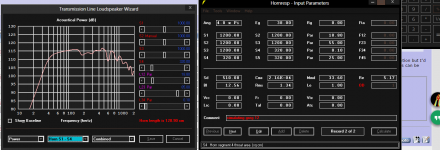Trigger warning: don't read any further if you can't stand a rant on transmission lines!
OK, here's the truth: TMLs are crap. Especially small ones.
Why? Because they resonate. Then a vented speaker is crap, too, you say? No, because a vented speaker only resonates on its tuning frequency (except you did something really stupid*), but a TML resonates on 1/4, 3/4, 5/4, and so on. What to do about it? Nothing! Well, not really, you can stuff the cabinet with absorbing foam/wool/sheets, whatever. And when you then measure again in the nearfield of the TML, you realize that you have just built a closed cabinet. Congratulations!
So you don't want a closed box? Then you will suffer from so many of these resonances, right in the speech and music frequency band, you must be deaf not to hear them. Compare the speaker to a well made closed cabinet then you'll know the difference.
Proof: look at the measurements of the small PMC bookshelves (can't provide scan for you due to copyright reasons, haven't found a link yet). Resonances whereever you like, a lot in one of the most important frequency bands.
What to do instead? Build a closed box. It's the best choice. Want more bass? Use bass reflex. It's a compromise for 2-ways, because it may also resonate like a TML when it is too long (then place the port on the back on the cabinet), or you will have snuffing noises.
*A transmission line IS a stupid bass reflex
Edit: the Faital driver is really great value for money! But don't use the 5FE100, it misses the demodulation ring.
Your complaint about a tapered tube of vented box volume filled with polyester fiber is valid. But it is not the original transmission line. Arthur Bailey design the transmission line for non-resonant (infinite baffler like) bass loading. His design works exactly as intended. See posts #21, #22, #29 and #43 of the following thread for more information.
http://www.diyaudio.com/forums/multi-way/275376-kef-b139b-sp1044.html

In a transmission line, the bass is tight with weight, very good control. You cannot fail to notice it when you compare the Bailey TL side-by-side with a closed box or some type of bass reflex. It has the bass extension of the bass reflex without the ringing effect. The fast transient and decay is very similar to that of a closed box. Take this from those who had buidt, measured and listened to the Bailey transmission line.
The misleading information on transmission line started when George Augspurger tried to "prove" that transmission line sounded the same as vented enclosure for commercial purpose. He published a JAES paper to prove his point. He made, purposedly or not, the erroeous assumption that all fiber were created equal and chose polyester as his stuffing. He saw the fiber velocity term in Bradbury's paper but did not noticed that Bradbury argued that, in long fiber wool, the fiber velocity is very small for most frequencies and thus can be consider stationary in bass loading. It is not surprising that the Augspurger transmission line sounded like bass reflex. It was designed to be so.
Last edited:
Here is a 46 inch box modeled with 15 inch external width. I realized that 34 inches is too short to be floor-standing for a seated audience, and the thinner width may be appealing. Note dimensions on right are the previous 34x18 design and the left side displays the 46x15 design.
Attachments
- Status
- This old topic is closed. If you want to reopen this topic, contact a moderator using the "Report Post" button.
